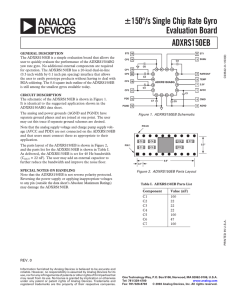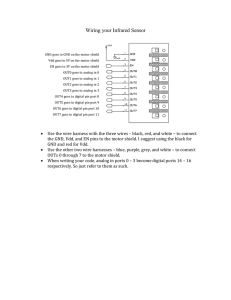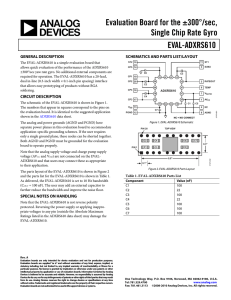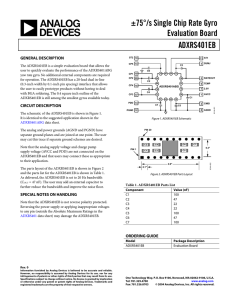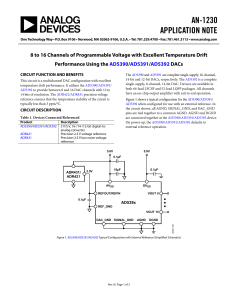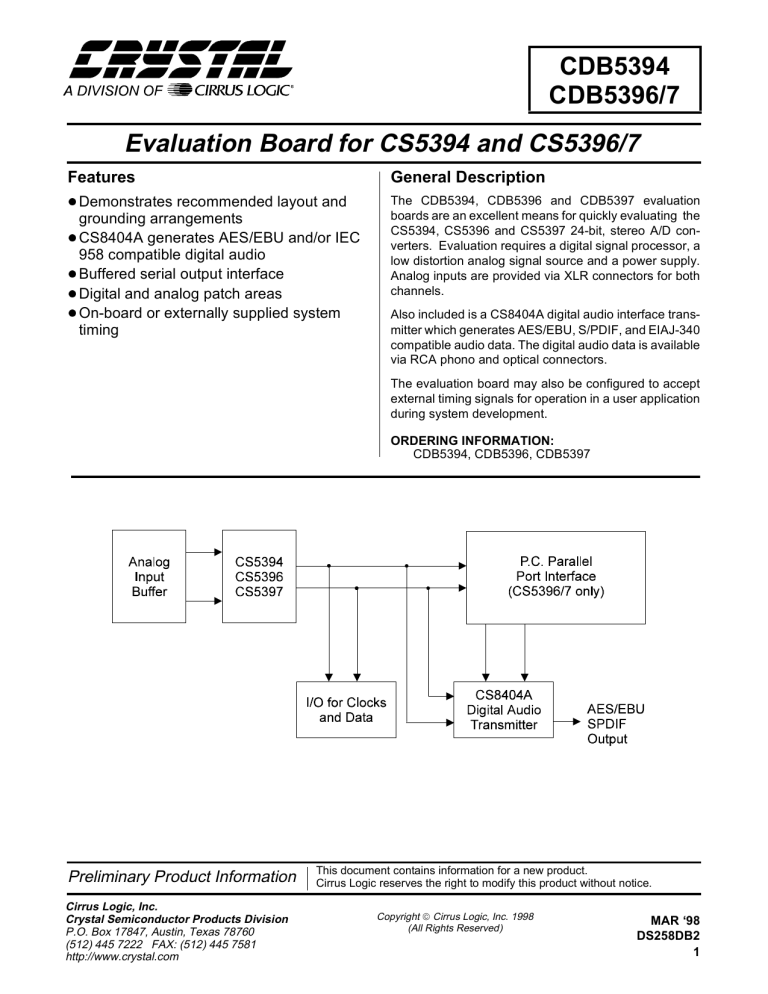
CDB5394
CDB5396/7
Evaluation Board for CS5394 and CS5396/7
Features
General Description
l Demonstrates recommended layout and
grounding arrangements
l CS8404A generates AES/EBU and/or IEC
958 compatible digital audio
l Buffered serial output interface
l Digital and analog patch areas
l On-board or externally supplied system
timing
The CDB5394, CDB5396 and CDB5397 evaluation
boards are an excellent means for quickly evaluating the
CS5394, CS5396 and CS5397 24-bit, stereo A/D converters. Evaluation requires a digital signal processor, a
low distortion analog signal source and a power supply.
Analog inputs are provided via XLR connectors for both
channels.
Also included is a CS8404A digital audio interface transmitter which generates AES/EBU, S/PDIF, and EIAJ-340
compatible audio data. The digital audio data is available
via RCA phono and optical connectors.
The evaluation board may also be configured to accept
external timing signals for operation in a user application
during system development.
ORDERING INFORMATION:
CDB5394, CDB5396, CDB5397
Preliminary Product Information
Cirrus Logic, Inc.
Crystal Semiconductor Products Division
P.O. Box 17847, Austin, Texas 78760
(512) 445 7222 FAX: (512) 445 7581
http://www.crystal.com
This document contains information for a new product.
Cirrus Logic reserves the right to modify this product without notice.
Copyright Cirrus Logic, Inc. 1998
(All Rights Reserved)
MAR ‘98
DS258DB2
1
CDB5394 CDB5396/7
OVERVIEW
CDB5394/96/97 System
The CDB5394/96/97 evaluation boards are an excellent means of quickly evaluating the CS5394,
CS5396 or CS5397. The CS8404A digital audio interface transmitter provides an easy interface to
digital audio signal processors, including the majority of digital audio test equipment. The evaluation board has been designed to accept an analog
input and provide optical and coaxial digital outputs. The evaluation board also allows the user to
access clocks and data through a 10-pin header for
system development.
The CDB5394/96/97 schematic has been partitioned into 7 schematics shown in Figures 2
through 8. Each partitioned schematic is represented in the system diagram shown in Figure 1. Notice
that the system diagram also includes the connections between the partitioned schematics.
Power Supply Circuitry and Grounding
Power is supplied to the evaluation board by six
binding posts as shown in Figure 8. +5VA provides
5 Volt power to the converter, VCOM buffer and
the crystal oscillator. The +/-12V binding posts
provide power to the analog input buffer. +5VD
supplies 5 Volt power to the digital section of the
board. Z1-Z4 are transient suppression diodes
which also provide protection from incorrectly
connected power supply leads.
Configuration for Stand-Alone or Control
Port Mode
Refer to Tables 2-4 for the jumper settings required
to configure the evaluation board.
Power-Down and Calibration - Stand alone
Mode
The CS5394 and CS5396/97 in Stand-Alone mode
are placed into the power-down mode simply by
depressing the PDN switch (S1). Power-down is re-
2
leased when the PDN switch is released. A calibration sequence should be manually initiated by
depressing the CAL switch (S2) following powerdown.
Power-Down and Calibration - Control Port
Mode for CDB5396/97 Only
Power-down and calibration are available only
through the control port. The calibration and power-down buttons on the evaluation board are ignored when configured in the Control Port mode.
Supplied Control Port Commands for
CDB5396/97
The evaluation board includes a set of DOS files
which allow communication through a PC parallel
port to the evaluation board.
The supplied commands include:
cal64x.bat - Performs a calibration and initialization sequence and sets the CS5396/97 into the 64X
oversampling mode.
cal128x.bat - Performs a calibration and initialization sequence and sets the CS5396/97 into the
128X oversampling mode.
rdi2c.exe <Map>- This routine returns the value
located in the register pointed to by <map>. The
<map> value is in hex and the value returned is in
hex.
wri2c.exe <map> <data> - This routine writes
the value of <data> into the register pointed to by
<map>. Both values are in hex.
rst.exe - Sends a reset command to the device.
mode128x.bat - Sets the device into the 128X
oversampling mode. The cal128x.bat command includes this sequence.
mode64x.bat - Sets the device into the 64X oversampling mode. The cal64x.bat command includes
this sequence.
DS258DB2
CDB5394 CDB5396/7
gnd.bat - Disconnects the analog modulators from
the input pins and attaches the modulator inputs to
the internal common mode voltage.
ungnd.bat - Disconnects the analog modulators
from the internal common mode voltage and attaches the modulator inputs to the input pins.
General Comments on the Parallel Port
The evaluation board will be partially powered
through the PC cable when the supplies to the evaluation board are off. This will affect the RC timing
circuit which places the CS5396/97 into the Control Port mode. It is required that the evaluation
board go through the power-up sequence without
the cable to the PC connected.
The CS5394/96/97 are able to withstand input currents of 100 mA maximum, as stated in the CS5394
and CS5396/7 data sheets. The OPA627 op-amp is
not able to deliver 100 mA, so input protection diodes are not required. However, protection diodes
are recommended if there is a possibility that overrange signals could be applied at the ADC inputs
which exceed 100 mA. Refer to the Crystal application note, “AN10: A/D Converter Input Protection Techniques.”
CS5394 and CS5396/7 A/D Converters
The CS5394/96/97 A/D converters are shown in
Figure 2. A description of these devices is included
in the CS5394 and CS5396/7 datasheets.
Input Buffer
CS8404A Digital Audio Interface
The differential input circuit shown in Figure 4 is
well-suited for the CS5394/96/7 in professional applications. The circuit will accept a differential or
single-ended signal of either polarity and provide a
differential signal with the proper DC offset to the
CS5394 or CS5396/97. The circuit also incorporates 6 dB of attenuation to scale down professional
input levels to the input voltage range of the
CS5394/96/97. A nominal input level of 13 Volts
rms to the evaluation board will achieve a full scale
digital output from the CS5394/96/97. The common mode rejection of the system is limited by the
passive component matching of the input buffer
circuit. The analog input connector is a standard female XLR with Pin 2 positive, Pin 3 return, and Pin
1 shield.
Figure 4 shows the circuitry for the CS8404A digital audio interface transmitter. The CS8404A can
implement AES/EBU, S/PDIF, and EIAJ-340 interface standards. The Digital Interface Format for
the transmitter must be set to match the format chosen for the CS5394 or CS5396/7 as defined in Tables 2-4. SW2 provides 8 DIP switches to select
various modes and bits for the CS8404A; switch
definitions and the default settings for SW2 are listed in Tables 5-6. Digital outputs are provided on an
RCA connector via an isolation transformer and on
an optical transmitter. For more detailed information on the CS8404A and the digital audio standards, see the CS8403A/CS8404A data sheet.
R1, R5, R16 and C65 form an RC network which
provides anti-alias filtering and the optimum
source impedance for the CS5394/96/97 right
channel inputs. R2, R3, R15 and C66 duplicate this
function for the left channel. Notice that this circuit
also provides approximately 13.25 dB attenuation
to lower the noise contributed from the analog input buffer.
DS258DB2
I/O Port for Clocks and Data
A serial output interface is provided on I/O Port_1,
as shown in Figure 6. When I/O Port is set to the
MASTER position, MCLK, SCLK, LRCK and
SDATA are outputs from I/O Port. When I/O Port
is in the SLAVE position, MCLK and SDATA are
outputs, while SCLK and LRCK become inputs.
Hence, in SLAVE mode, the SCLK and LRCK signals must be externally derived from MCLK to run
the ADC. All signals are buffered in order to isolate
the converter from external circuitry. Note that the
3
CDB5394 CDB5396/7
CS5394/96/97 must also be properly configured for
Slave or Master mode.
CS8404A Format Configuration
The CS5394/96/97 supports two Digital Interface
Formats for both master and slave configurations.
Format 0 has valid data on the rising edge of SCLK
and the CS8404A has no corresponding mode.
However, inverting SCLK so that data is valid on
the falling edge of SCLK will make Format 0 of the
CS5394/96/97 match Format 1 of the CS8404A.
Jumpers are available to configure the CS8404A to
Format 1 and perform inversion of SCLK. See Tables 4-6.
Digital Interface Format 1 is the I2S compatible
mode and matches Format 4 of the transmitter. Refer to Tables 4-6 for jumper positions.
CS8404A MCLK Generation
The crystal oscillator (U5) is either 256x for the
64x oversampling mode or 512x for the 128x oversampling mode. However, the CS8404A requires a
master clock frequency of 128x Fs. Therefore, the
4
MCLK must be divided by either 2 or 4 depending
on the mode of operation. Refer to Tables 4-6 for
the proper jumper selection.
Grounding and Power Supply Decoupling
The CS5394/96/97 require careful attention to
power supply and grounding arrangements to optimize performance. The CS5394/96/97 is positioned over the analog ground plane.
This layout technique is used to minimize digital
noise and to insure proper power supply matching/sequencing. The decoupling capacitors are located as close to the ADC as possible. Extensive
use of ground plane fill on both the analog and digital sections of the evaluation board yields large reductions in radiated noise effects.
The evaluation board uses separate analog and digital ground planes which are joined at the converter. This arrangement isolates the analog circuitry
from the digital logic.
DS258DB2
CDB5394 CDB5396/7
CONNECTOR
+5VA
+5VD
±12V
AGND
DGND
AINL
AINR
LRCK, SCLK
MCLK
SDATA
coaxial output
optical output
INPUT/OUTPUT
input
input
input
input
input
input
input
input/output
output
output
output
output
SIGNAL PRESENT
+5 Volts for analog section
+5 Volts for digital section
±12 Volts for analog input
Analog ground connection from power source
Digital ground connection from power source
Left channel differential/single ended analog input
Right channel differential/single ended analog input
I/O for serial and left/right clocks
Master clock output
Serial data output
CS8404A digital output via transformer
CS8404A digital output via optical transmitter
Table 1. System Connections
Jumper
HDR1
HDR7
HDR8
HDR10
HDR11
SDATA
I/O Port
8404A
Mode 1
Mode 2
Mode 3
CS8404A
CS5396/97
Purpose
Sets the proper pull-up for the parallel port
Sets the proper pull-up for the parallel port
Sets the proper pull-up for the parallel port
Selects Stand-Alone or Control Port
mode
Selects I2C or SPI mode for
CS5396/97 control port
Selection of data source for output
from the SPDIF and I/O port
I/O port Slave or Master selection
Sets CS8404A data format selection for CS5396/97 compatibility.
All jumpers must be set to either
I2S or LJ and be compatible with
the CS5396/97 data format.
MCLK divide for CS8404 and
CS5396/97 compatibility
Supports a future function of the
CS5396/97
Position
High
Low
High
Low
High
Low
High
Low
High
Low
1
2
Slave
Master
I2S
LJ
128 x
64 x
High
Low
Function Selected
Selects a 2k pull-up for I2C compliance
Invalid selection for uC mode
Selects a 2k pull-up for I2C compliance
Invalid selection for uC mode
Selects a 2k pull-up for I2C compliance
Invalid selection for Control Port mode
Selects Control Port Mode
Invalid selection for Control Port Mode
Selects I2C mode
Selects SPI Mode
Selects SDATA1
Selects SDATA2
LRCK and SDATA are inputs to the port.
LRCK and SDATA are outputs from the port
I2S data format selected
Left Justified data format selected
Divide MCLK by 4 for 128x oversampling mode
Divide MCLK by 2 for 64x oversampling mode
Invalid selection
Should be set LOW
Bold indicates default settings
Table 2. CDB5396 and CDB5397 Control Port Mode jumper Setting
DS258DB2
5
CDB5394 CDB5396/7
Jumper
HDR1
HDR7
HDR8
HDR10
HDR11
SDATA
I/O Port
8404A
Mode 1
Mode 2
Mode 3
CS8404A
CS5396/97
Jumper
HDR1
HDR7
HDR8
HDR10
HDR11
SDATA
I/O Port
8404A
Mode 1
Mode 2
Mode 3
CS8404A
CS5396/97
Purpose
Secondary effect on power-down
implementation
CS5396/97 digital data format selection
CS5396/97 Master or Slave mode
selection
Selects Stand-alone or Control Port
mode
Selects polarity of power-down
Selection of Data source for output
from the SPDIF and I/O port
I/O port Slave or Master selection
Position
High
Low
High
Low
High
Low
High
Low
High
Low
1
2
Slave
Master
I2S
LJ
Function Selected
Invalid selection for Stand-alone Mode
Must be set low for operation
Selects I2S data format
Selects Left justified data format
Selects Slave Mode
Selects Master Mode
Selects Control Port Mode
Selects Stand-alone Mode
Must be set High
Invalid selection, CDB will not function
Selects SDATA1
Selects SDATA2
LRCK and SDATA are inputs to the port
LRCK and SDATA are outputs from the port
I2S data format selected
Left Justified data format selected
Position
High
Low
High
Low
High
Low
High
Low
High
Low
1
2
Slave
Master
I2S
LJ
Function Selected
Invalid selection for Stand-alone Mode
Must be set low for operation
Selects I2S data format
Selects Left justified data format
Selects Slave Mode
Selects Master Mode
Invalid selection for CS5394
Selects Stand-alone Mode
Must be set High
Invalid selection, CDB will not function
Selects SDATA1
Invalid selection for CS5394
LRCK and SDATA are inputs to the port
LRCK and SDATA are outputs from the port
I2S data format selected
Left Justified data format selected
Sets CS8404A data format selection
for CS5396/97 compatibility. All
jumpers must be set to either I2S or
LJ and be compatible with the
CS5396/97 data format (HDR7)
MCLK divide for CS8404 and
128 x
Divide MCLK by 4 for 128x oversampling mode
CS5396/97 compatibility
64 x
Divide MCLK by 2 for 64x oversampling mode
Supports a future function of the
High
Invalid selection
CS5396/97
Low
Should be set LOW
Table 3. CDB5396 and CDB5397 Stand-Alone Mode Jumper Settings
Purpose
Secondary effect on power-down
implementation
CS5394 digital data format selection
CS5394 Master or Slave mode
selection
Selects Stand-alone or Control
Port mode
Selects polarity of power-down
Selection of Data source for output
from the SPDIF and I/O port
I/O port Slave or Master selection
Sets CS8404A data format selection for CS5394 compatibility. All
jumpers must be set to either I2S
or LJ and be compatible with the
CS5394 data format (HDR7)
MCLK divide for CS8404 and
CS5394 compatibility
Supports a future function of the
CS5396/97
128 x
64 x
High
Low
Invalid selection for CS5394
Divide MCLK by 2 for 64x oversampling mode
Invalid selection
Should be set LOW
Bold indicates default settings
Table 4. CDB5394 Jumper Settings
6
DS258DB2
CDB5394 CDB5396/7
Switch#
6
8, 5
7
4
3
1, 2
0=Closed, 1=Open
PRO=0
FC1, FC0
00
*0 1
10
11
C3
*1
0
C2
*1
0
C15
*1
0
C8, C9
11
10
01
*0 0
Comment
Consumer Mode (C0=0)
C24,C25,C26,C27 - Sample Frequency
0000 - 44.1 kHz
0100 - 48 kHz
1100 - 32 kHz
0000 - 44.1 kHz, CD Mode
C3,C4,C5 - Emphasis (1 of 3 bits)
000 - None
100 - 50/15 µs
C2 - Copy/Copyright
0 - Copy Inhibited/Copyright Asserted
1 - Copy Permitted/Copyright Not Asserted
C15 - Generation Status
0 - Definition is based on category code
1 - See CS8402A Data Sheet, App. A
C8-C14 - Category Code (2 of 7 bits)
0000000 - General
0100000 - PCM encoder/decoder
1000000 - Compact Disk - CD
1100000 - Digital Audio Tape - DAT
Table 5. CS8404A Switch Definitions - Consumer Mode
Switch#
6
8
7, 4
5
3
1, 2
0=Closed, 1=Open
PRO=1
CRE
0
1
C6, C7
11
10
01
00
C1
1
0
C9
1
0
EM1, EM0
11
10
01
00
Comment
Professional Mode (C0=1)
Local Sample Address Counter & Reliability Flags
Disabled
Internally Generated
C6,C7 - Sample Frequency
00 - Not Indicated - Default to 48 kHz
01 - 48 kHz
10 - 44.1 kHz
11 - 32 kHz
C1 - Audio
0 - Normal Audio
1 - Non-Audio
C8,C9,C10,C11 - Channel Mode (1 of 4 bits)
0000 - Not indicated - Default to 2-channel
0100 - Stereophonic
C2,C3,C4 - Emphasis (2 of 3 bits)
000 - Not Indicated - Default to none
100 - No Emphasis
110 - 50/15 µs
111 - CCITT J.17
Table 6. CS8404A Switch Definitions - Professional Mode
DS258DB2
7
CDB5394 CDB5396/7
Fig. 5
Fig. 2
Fig. 4
Fig. 7
Fig. 6
Fig. 3
Figure 1. System Block Diagram and Signal Flow
8
DS258DB2
DS258DB2
MCLK
U?
C64
100UF
C18
.1UF
X7R
1
2
1
2
3
4
AINL+
AINL-
5
6
6
7
AGND
8
4
V-
AGND
9
10
CAL
11
VBIAS1
R18
+
1K
7
R26
C8
10UF
6
OPA2132U
U15
VBIAS2
12
5
C19
.1UF
X7R
13
LRCK
SCLK
14
VREF
VCOM
AGND
AINL+
AINLADCTL
MCLKA
TST01
DACTL
CAL
VD+
DGND
LRCK
SCLK
AGND
AINR+
AINRAGND
VA+
VL+
LGND
TST02
MCLKD
PDN
DFS
S/\M
SDATA1
SDATA2
27
C61
.1UF
X7R
AINR+
AINR-
26
25
C42
.01UF
X7R
24
23
23
+5VD
+
3
-
1
2
8
AGND
C47
.01UF
X7R
C62
.1UF
X7R
4.7
+5VA2
C17
.1UF
X7R
22
21
20
19
18
17
16
15
CS/PDN
AGND
CDIN/DFS
CCLK/SMB
SDATA2
SDATA1
+VD2
CS5396
1K
R17
+5VA2
28
AGND
L4
FERRITE_BEAD
L6
FERRITE_BEAD
R11
47K
V+
SN74HC125N
C28
AGND
X7R
.1UF
GND
SDATA
+5VA
1
47K
1
LO
R13
+5VD
HDR10
1
SDATA
HI
HDR2
6
HI
5
LO
+VD2
U12
4
R21
100K
R6
47K
D1
BAT85
C67
100UF
GND2
25V
GND2
9
CDB5394 CDB5396/7
Figure 2. CS5394 and CS5396/7 Connections
10
+5VD
C23
.01UF
VCC
14
U11
1
GND
2
SN74HC04N
GND
7
LEFT JUSTIFIED
GND
SCLK
I2S
1
8404_MODE_3
LRCK
SDATA
7
8
6
TP11
TP2
15
TP1
TP3
TP4
10
TP6
TP5
11
GND
RN4
47K
C7/C3
PRO
CBL
C1/FC0
9
+5VD
1
GND
GND
24
CRE/FC1
V
C6/C2
C9/C15
C
EM0/C9
*
U
EM1/C8
2
SW2
3
8
7
6
5
4
3
2
1
4
12
14
13
+5VD
U14
21
M0
/RST
+5VD
HI
TXP
M2
TXN
MCK
23
M1
HI
8404_MODE_2
SW_DIP_8
16
GND
CS8404A_CS
22
20
C50
.1UF R50
X7R
XFR_PE_67129600
TR1
374
5
R56
90.9
17
5
GND
+5VD
5
GND
4
8.2K
2
1
6
+5VD
GND
S
+5VD
5
S
+5VD
C1
12
2
1
+5VD
9
11
C1
1D
GND
10
1
3
X7R
.1UF
HDR3
OPT1
GND
U1
74HC74A
128X
R
6
1D
64X
8
13
+5VD
4
NC
CON_RCA_RA
R
DS258DB2
MCLK
Figure 3. CS8404A Digital Audio Transmitter and Connections
GND
CDB5394 CDB5396/7
R20
GND
GND
3
U1
74HC74A
6
TOTX173
LO
4
1
3
2
M2
GND
C27
J3
4
1
1
LO
3
2
8404_MODE_1
1
M0
OPEN
SCK
VD+
18
SDATA
19
C22
.1UF
X7R
C37
10UF
FSYNC
+5VD
CDB5394 CDB5396/7
+12V
XR7
.1UF
C53
+12V
7
V+
AGND
U2
OPA627AP
2
R28
1M
-
ANALOG
R5
6
187
ANALOG
R47
7.77K
3
+
0.1%
ANALOG
-12V
4
V-
1 5
XR7
.1UF
C52
C9
100UF
R46
7.77K
C14
100PF
NPO
C12
100PF
NPO
0.1%
AGND
C4
25V
10PF
NPO
R7
1M
+12V
ANALOG
ANALOG
C54
ANALOG
.1UF
X7R
7
U4
OPA627AP
J2
XLR
3
R16
100
ANALOG
C65
3300PF
COG
V+
AGND
2
ANALOG
AINR+
R45
10K
0.1%
2
-
6
C13
100PF
NPO
1
3
+
-12V
C55
5 1
4
VBIAS1
C48
V-
X7R
.1UF
.1UF
X7R
R44
10K
0.1%
C34
AGND
X7R
.1UF
+12V
AGND
AGND
C30
470UF
16V
AGND
AGND
ANALOG
R48
7.77K
C11
100PF
NPO
C31
100UF
V+
U3
OPA627AP
7
2
-
0.1%
ANALOG
R1
6
187
ANALOG
R49
7.77K
3
+12V
V.1UF
X7R
AGND
R25
1M
25V
C70
470UF
1 5
-12V
+12V
XR7
.1UF
C59
AGND
C69
470UF
1M
R27
R60
4
C35
16V
-12V
+12V
7.77K
V+
7
AGND
U6
OPA627AP
ANALOG
2
16V
-12V
3
187
4
0.1%
C45
100PF
NPO
XR7
.1UF
ANALOG
10PF AGND
NPO
C26
25V
R57
10K
0.1%
-12V
1 5
C58
R59
7.77K
R4
1M
R15
100
ANALOG
AGND
ANALOG
AINL+
+
V-
C44
100PF
NPO
R3
6
ANALOG
0.1%
C15
100UF
AINR-
+
0.1%
.1UF
X7R
+12V
C66
3300PF
COG
C36
J1
XLR
3
7
U7
OPA627AP
2
V+
2
-
6
ANALOG
1
C46
100PF
NPO
AGND
ANALOG
ANALOG
C43
100PF
NPO
C16
100UF
AGND
3
+
5 1
C39
4
V-
.1UF
X7R
VBIAS2
C56
X7R
.1UF
-12V
R61
7.77K
C25
470UF
R58
10K
0.1%
16V
AGND
AGND
0.1%
ANALOG
7.77K
0.1%
.1UF
X7R
+12V
R24
1M
25V
AGND
R64
V+
C40
7
R2
U8
2
187
AINL-
OPA627AP ANALOG
-
6
3
-12V
+
AGND
V.1UF
X7R
4
1 5
-12V
C38
Figure 4. Analog Input Buffer
DS258DB2
11
12
CDB5394 CDB5396/7
DS258DB2
Figure 5. P.C. Parallel Interface
CDB5394 CDB5396/7
Figure 6. I/O Interface for Clocks & Data
Figure 7. CAL Circuitry
DS258DB2
13
CDB5394 CDB5396/7
L1
FERRITE_BEAD
+5VD
+VD2
L2
FERRITE_BEAD
DIGITAL +5VD
J4
C60
.1UF
X7R
DIGITAL DGND
C57
47UF
P6KE6V8P
J9
C10
.1UF
X7R
C41
470UF
16V
Z4
C24
470UF
16V
J7
+12V
Z1
P6KE13
ANALOG
AGND
J8
Z2
P6KE13
-12V
C20
.1UF
TO GND2
GND
+12V
X7R
J5
C?
470UF
16V
C?
470UF
16V
C3
.22UF
C2
.22UF
AGND
-12V
L5
FERRITE_BEAD
ANALOG
+5VA
J6
+5VA1
+5VA
C?
470UF
16V
Z3
P6KE6V8P
AGND
C1
.22UF
L3
FERRITE_BEAD
+5VA2
Figure 8. Power Supply & Reset Circuitry
14
DS258DB2
CDB5394 CDB5396/7
Figure 9. CDB5394 and CDB5396/7 Component Silkscreen Side (top)
DS258DB2
15
CDB5394 CDB5396/7
Figure 10. CDB5394 and CDB5396/7 Component Silkscreen Side (bottom)
16
DS258DB2
CDB5394 CDB5396/7
Figure 11. CDB5394 and CDB5396/7 Component Copper Side (top)
DS258DB2
17
CDB5394 CDB5396/7
Figure 12. CDB5394 and CDB5396/7 Component Copper Side (bottom)
18
DS258DB2
• Notes •

